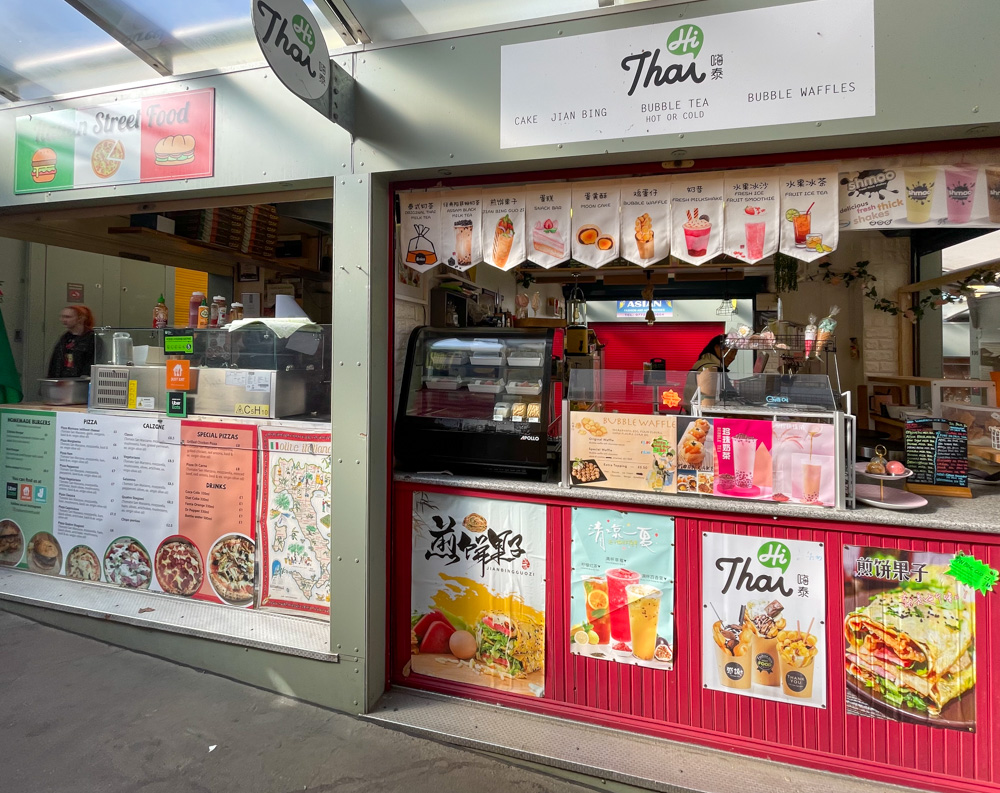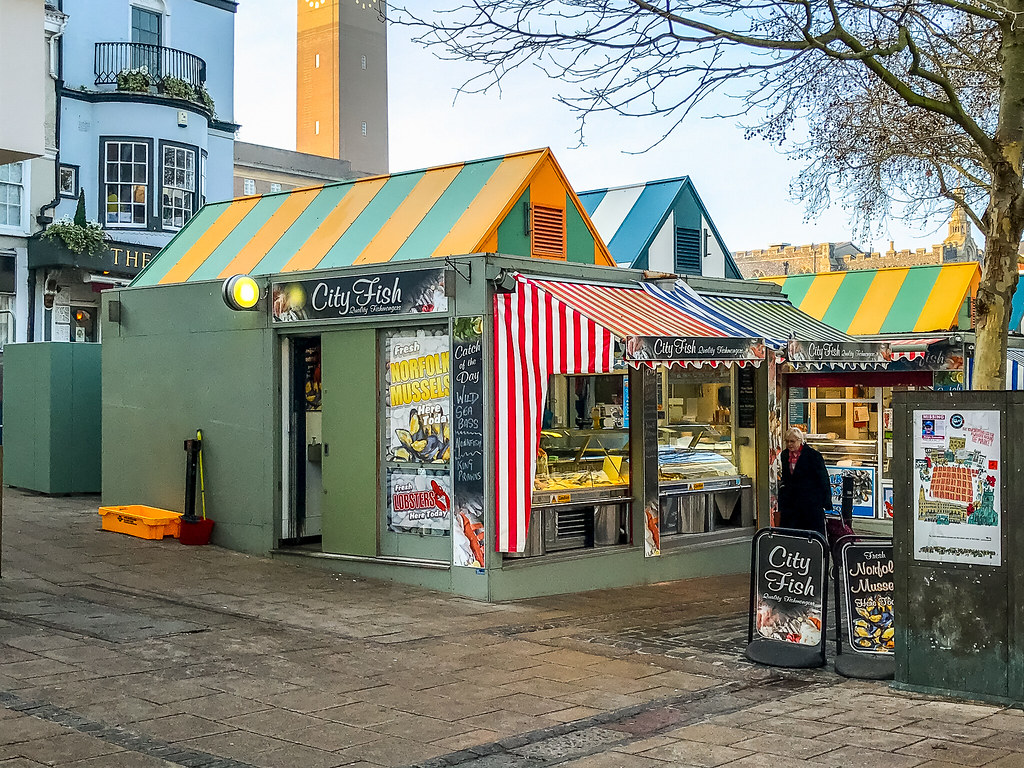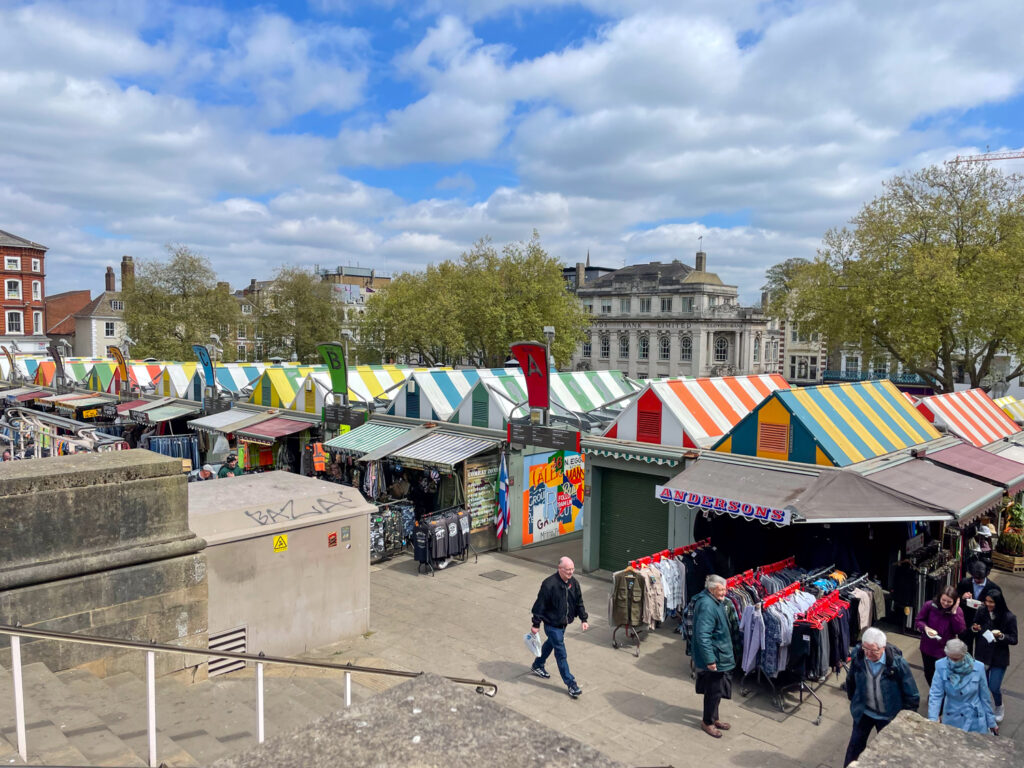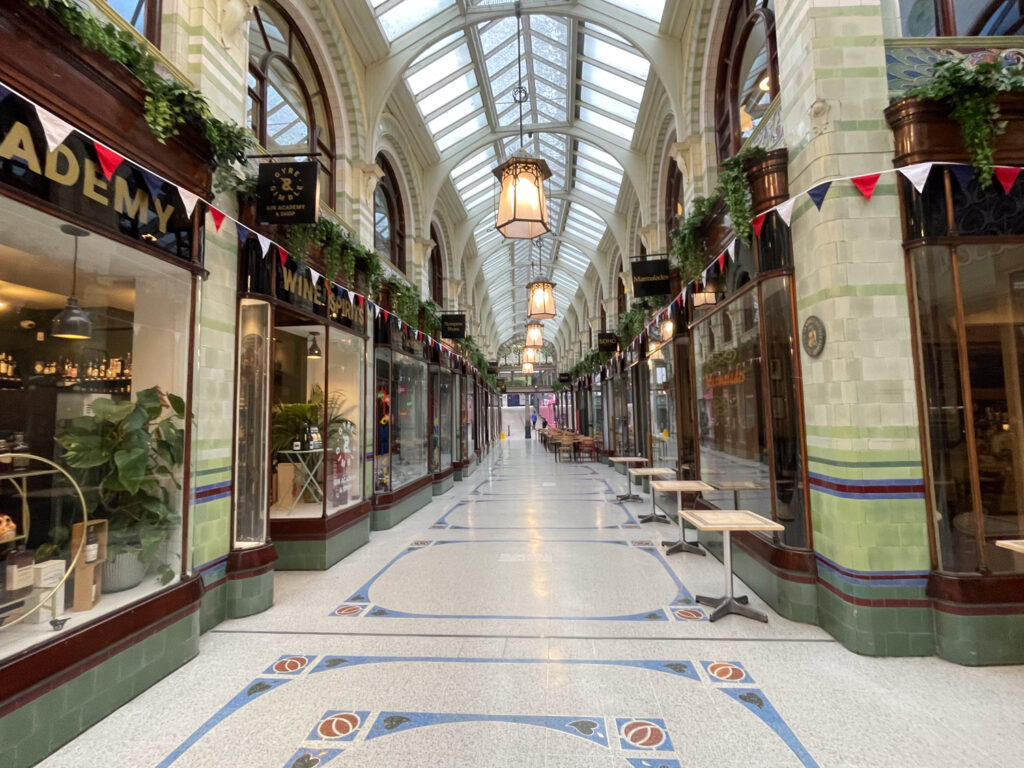In the heart of Norwich, just a few steps from the majestic castle and the elegant Royal Arcade, the vibrant patchwork of Norwich Market colourful rooftops instantly draws your eye. With over 900 years of history and more than 200 stalls, it’s one of the oldest and most charming open-air markets in the United Kingdom. This historic market square is more than just a shopping destination; visiting it, you’re going on a journey through local life, food culture, and centuries of tradition.
Table of Contents
Why You Should Visit Norwich Market
With over 900 years of continuous activity, Norwich Market proudly holds the title of one of the oldest and largest open-air markets in the United Kingdom. Wandering through its colourful stalls, you can soak up the atmosphere of a truly British market, where heritage and modern life blend effortlessly. From handmade crafts to global street food, it’s the perfect place to experience Norwich in its most authentic way.
PLAN YOUR TRIP TO ENGLAND
Stay connected in England with a giffgaff free SIM or an Airalo eSim for seamless data coverage throughout the UK. Additionally, rent a car in the United Kingdom to explore all the attractions of the British countryside, including the fantastic museums on my blog!
Despite spending a lot of time in Norwich, I still haven’t managed to try every single stall: there are simply too many to count. But I always indulge in a proper portion of fish and chips, served piping hot and beautifully crisp.
If you’re in the mood for something more adventurous, the food options here are truly international. You’ll find everything from sweet and sour Chinese dishes and Thai bubble tea to freshly grilled Italian paninis.
And it’s not just about the food. If you enjoy photography, the flower stalls are an absolute dream. Buckets brimming with tulips, roses, and wildflowers spill out onto the cobbles, offering a burst of colour and texture that’s hard to resist.

What to Buy at Norwich Market
Walking through Norwich Market is like a mini world tour with a Norfolk twist. The market is divided into neat rows, each one filled with independent traders who’ve been selling their goods here for generations.
It’s the kind of place where you might come looking for lunch and leave with a vintage dress, a jar of locally-made chutney, and a bunch of daffodils.
If you’re lucky, you might catch a live music performance in front of the market, especially on weekends. In fact, it’s pretty common to see a busker playing acoustic guitar or a small brass band livening up the lunchtime crowd.

A Brief History of Norwich Market
To understand the importance of Norwich Market, you have to look back to the 11th century. After the Norman conquest of England, Norwich quickly became one of the largest and wealthiest towns in the country, thanks to its strategic position between London and the North Sea.
The market was established in the same location where it still stands today. Initially, it was a gathering place for farmers, artisans, and traders who brought their goods into the city walls. Over the centuries, the market evolved, expanded, and survived wars, plagues, and economic crises.
The Market as Norwich’s Economic Engine
From the Middle Ages onwards, Norwich Market was the city’s primary commercial hub. It was carefully organised by product type, with rows dedicated to meat, fish, cloth, and vegetables. Surrounding the market square, inns and taverns welcomed traders and travellers, turning the area into a social and economic focal point.
Norwich’s wealth was also tied to its unusual status. In 1341, the city obtained a tax exemption from King Edward III after impressing the royal family during a jousting tournament. This fiscal privilege allowed local businesses to flourish and the market to grow.

The Plague and the Collapse of the Local Economy
In the 15th century, the Black Death struck Norwich with devastating consequences. The population dropped from around 20,000 to under 6,000.
Although the city avoided uprisings or chaos, the economy ground to a halt. The once-bustling market square became eerily quiet. But Norwich would bounce back, and the market with it.
Imported Goods and Entertainment in the 16th and 17th Centuries
As trade resumed, Norwich Market became a gateway for imported goods. Sugar, dried fruit, and spices began to appear on the stalls, turning everyday shopping into something more exciting.
One fascinating historical record from 1581 shows that during the Feast of St. Bartholomew, the market sold over 20,000 oranges and 1,000 lemons, an astonishing number for the time, considering citrus fruits were considered luxury items.
During the 17th century, the market also became a place of spectacle. Travelling entertainers set up shows: acrobats, magicians, animals, and even freak shows were common. Norwich Market was not just a place to shop but also a place to see and be seen.
Georgian Elegance and Victorian Progress
By the 18th century, Norwich was thriving again. The Georgian era brought a taste for elegance, and the market evolved with it.
Wealthy visitors came to Norwich to shop, and the buildings surrounding the market were turned into boutiques. You can learn more about Norwich’s commercial past at the Museum of Norwich at the Bridewell.
The Royal Arcade, a shopping arcade designed in 1899 by George Skipper, became a symbol of this refined shopping experience. Its Art Nouveau design still stands proudly beside the market.

Twentieth-Century Modernisation
After World War I, the market area became overcrowded and chaotic, with privately owned stalls creating logistical nightmares. In the 1930s, a large-scale redevelopment was launched. The local government purchased the stalls, reorganised the layout into tidy rows, and constructed the current Norwich City Hall beside the square.
The current stalls, though modern in structure, retain the colourful roofs that make the market so iconic today. Made of steel and aluminium, each unit contains four stalls, giving the market a modular, well-organised appearance that still reflects its lively soul.
What to See Nearby Norwich Market
Norwich Market is ideally located in the heart of the city, making it an ideal base to explore Norwich’s main attractions. Within just a few steps, you’ll find a mix of history, culture, and architectural beauty:
- The Royal Arcade, a stunning Art Nouveau shopping arcade, perfect for boutique browsing and architectural photography.
- Norwich Castle Museum & Art Gallery, set inside a Norman castle, offers fascinating displays on local history, archaeology, and fine art.
- Museum of Norwich at the Bridewell, a hidden gem that tells the story of the city’s past trades, industries, and everyday life.
- The Forum, a modern glass building hosting the public library, exhibitions, community events, and several cafés with views over the market square. My son and I have participated in several children’s activities there. It’s one of our favourite places to relax while reading a book.
- Norwich Cathedral, known for its soaring spire and peaceful cloisters, the cathedral is a quiet escape with a riverside walk just behind it.
- Elm Hill, one of the oldest streets in England, with cobbled lanes, timber-framed houses, antique shops, and a wonderfully nostalgic atmosphere.
Take your time to stroll through the city centre and enjoy the blend of medieval streets and modern amenities. Whether you’re here for a few hours or a whole weekend, everything is within easy walking distance from Norwich Market.

Practical Tips for Visiting Norwich Market
Norwich Market is a must-see for anyone visiting the city. There are several options for getting there, including car and public transport.
Opening Hours and the Best Days to Visit
Norwich Market is open Monday to Saturday, from 8:30am to 5:00pm, and each part of the day offers a different experience. If you prefer a quieter atmosphere, the best time to visit is in the morning, when the traders are just setting up and the market feels calm and relaxed.
If you’re after something to eat, head there around lunchtime when the market comes alive with the scent of sizzling street food. It’s the busiest time of day, especially around the most popular food stalls, so be prepared for a bit of a queue.
Whether you’re in the mood for a relaxed morning wander or a lively lunch break, the market’s vibrant rhythm changes throughout the day, giving you a reason to return more than once.
How to Get to Norwich Market
Norwich Market is located on Gentleman’s Walk, right in the city centre. If you’re arriving by train, it’s about a 15-minute walk from Norwich Station. Several bus routes stop nearby, making it easily accessible by public transport.
If you’re driving, you can use one of the central car parks, such as Castle Mall or The Forum, both just a few minutes walk from the market. Day rates are affordable, especially compared to London or Cambridge.
However, if you’re staying in town, walking is the easiest option.
Norwich Market
1 Market Place, Norwich NR2 1ND
Where to Stay in Norwich
Norwich is one of my favourite cities in Europe. I lived there for a time and return frequently, whether on my own or with my son, to visit museums and catch up with friends. Therefore, I can recommend fantastic hotels that I have personally experienced.
For a truly British experience you can stay at The Maids Head Hotel, an elegant hotel with restaurant and free parking opposite the Cathedral, just a stone’s throw from Elm Hill, two of Norwich’s most popular attractions. If you arrive by train and prefer a flat, the Wellington Apartments have studios with a kitchen, reception open 24/7, garden and free WiFi in the centre of Norwich, close to the train station.
Final Thoughts on Norwich Market
In summary, Norwich Market is much more than just a place to shop. Surrounded by stunning architecture and some of Norwich’s best attractions, it’s a vibrant hub of history, culture, and community spirit that has thrived for over nine centuries.
There, you can live a truly authentic experience, whether you’re sampling traditional British favourites like fish and chips, exploring international street food, or simply soaking up the colourful atmosphere.
Feel free to leave a comment below and share your thoughts or your favourite memories from Norwich Market. I look forward to reading about your experiences!
